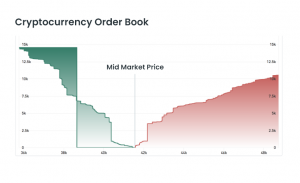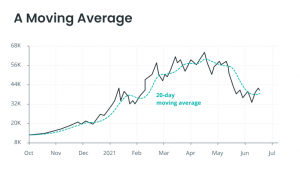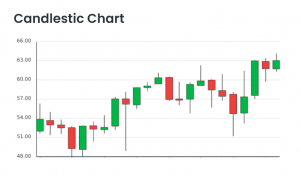Quoted the words of Jimm Rickard, “Gold is a great way to preserve wealth, but it is hard to move around. You do need some kind of alternative & Bitcoin fits the bill”.
Yes, rightly it is said….! Want to know why so? Let’s learn from the beginning……..
Cryptocurrencies are a sort of decentralized, non-government-controlled digital currency. Cryptocurrencies have a long history; in the 1980s, they were known as “cyber currencies.” With the release of Bitcoin, which was developed by an unidentified programmer or group of programmers under the name Satoshi Nakamoto, these coins began to acquire prominence.
Cryptocurrencies have gained popularity since the release of Bitcoin in 2009. Their appeal has increased as more and more people invest in them over the last several years. What are they, though? And from where did they originate?
The idea of Cryptocurrencies (1980’s)
In 1980, a few years after the first mention of cryptocurrencies, American cryptographer David Chaum created digital cash, which used cryptography to safeguard and verify transactions. However, the software and cryptographic methods that would enable the establishment of a genuinely decentralized digital currency didn’t start to be developed until the early 1990s.
In a document published in October 2008 under the pseudonym Satoshi Nakamoto, a system for developing digital money that did not require faith in any third party was described. Nakamoto’s work served as the catalyst for the emergence of cryptocurrencies.
The Initial Stage
The Bitcoin white paper, outlining the operation of the Bitcoin blockchain network, was released on October 31, 2008, by Satoshi Nakamoto. When Satoshi bought Bitcoin.org on August 18, 2008, they formally started working on the bitcoin project. Although it’s not the focus of this article, it’s important to note that blockchain technology, which at its most basic level is constructing immutable data structures, is essential to the existence of Bitcoin (and all other cryptocurrencies).
The development of Bitcoin was in progress. On January 3, 2009, Satoshi Nakamoto mined the first block of the Bitcoin network. In this first block, they included a headline from The Times, providing a permanent allusion to the economic circumstances—involving bank bailouts and a centralized financial system—that Bitcoin was in part a reaction against.
The Genesis Block is the name given to this initial block, which led to the mining of 50 bitcoins. During this time, as well as the first few months of its existence, bitcoin had essentially no value. In April 2010, six months after bitcoin first became tradable, one BTC was worth just under 14 cents. The cost “rose” to 36 cents by early November before leveling off at about 29 cents.
The Earliest Development of the Crypto Market
At the beginning of 2010, Bitcoin was the only cryptocurrency available. It cost only a few cents at the time. New digital currencies entered the market throughout the ensuing years, and their values fluctuated along with that of Bitcoin.
During this time of turbulence, many people lost hope in cryptocurrencies as an avenue for investing. However, cryptos started to experience exceptional growth starting in late 2017. Prior to falling later that month, the combined market capitalization of all cryptocurrencies had hit $820 billion in January 2018. The cryptocurrency market has grown consistently throughout, despite this crash.
The Crypto Scam Era
The year of cryptocurrencies was 2017. The number of schemes and frauds aimed at cryptocurrency investors also increased as the value of Bitcoin and other digital money soared. Fraudulent Initial Coin Offerings (ICOs) and phishing scams allowed thieves to steal millions of dollars from unwitting victims eager to cash in on the cryptocurrency frenzy. Regulators’ focus on the cryptocurrency industry will probably result in an increase in fraud by 2022.
Increase In the Popularity Of Bitcoin
Although Bitcoin has been the focus of several conversations and debates, it is difficult to say exactly when it first gained popularity. Many people think that Bitcoin’s surge, from $1,000 to $20,000 before falling back to $10,000, occurred in 2017. Others contend that cryptocurrency exchanges like Coinbase, which made it simpler for those with little technical expertise or experience to trade cryptocurrencies, are to blame for the meteoric rise in popularity of Bitcoin.
Whatever the cause, one thing is certain: As more people learn about what Bitcoin stands for – decentralization and anonymity – its popularity will increase.
Top 10 Cryptocurrencies to Know
The market for cryptocurrencies is expanding rapidly and is only anticipated to do so. Cryptocurrencies will undoubtedly play a significant part in the structure of our future monetary system as the digital economy expands at an exponential rate.
There are many different kinds of cryptos available today; some have shown to be more stable than others while still showing development potential. Spend some time learning about these fascinating currencies……
1. Bitcoin (BTC)
Market Capitalization: $389.8 billion
The initial cryptocurrency is Bitcoin (BTC), which Satoshi Nakamoto created in 2009. BTC operates on a blockchain, which is a ledger that records transactions and is shared across a network of thousands of computers, like the majority of other cryptocurrencies. Bitcoin is maintained secure and protected from fraudsters because updates to the distributed ledgers have to be validated by cracking a cryptographic puzzle, a procedure known as proof of work.
As Bitcoin has gained popularity, its price has risen. The price of a single Bitcoin in May 2016 was roughly $500. On November 8, 2022, the cost of one Bitcoin was approximately $20,301. That represents a 3,960% increase.
2. Ethereum (ETH)

Market Capitalization: $189.3 billion
Because of its potential applications, including so-called “smart contracts” that automatically execute when certain conditions are met and non-fungible tokens, Ethereum—which is both a cryptocurrency and a blockchain platform—is a darling among programmers (NFTs).
Ethereum has also grown incredibly fast. Its price increased by 13,965% between April 2016 and the end of November 2022, from about $11 to about $1,547.
3. Tether (USDT)

Market Capitalization: $69.5 billion
Tether (USDT) is a stablecoin, which means it’s backed by fiat currencies like U.S. dollars and euros and theoretically maintains a value equal to one of those denominations, unlike certain other types of cryptocurrencies. As a result, investors who are cautious of the severe volatility of other coins choose Tether because its value is theoretically expected to be more stable than that of other cryptocurrencies.
4. Binance Coin (BNB)
Capitalization: $61.1 billion
One of the biggest cryptocurrency exchanges in the world, Binance, accepts payments in the form of Binance Coin (BNB), a type of cryptocurrency. Binance Coin has grown since it was introduced in 2017, and it now does more than just enable transactions on Binance’s exchange platform. Now, it can be utilized for trading, processing payments, or even making trip plans. Additionally, it can be traded or converted into other cryptocurrencies like Ethereum or Bitcoin.
In 2017, BNB cost only $0.10. Its price has increased to about $382 by the end of November 2022, a gain of 382,065%.
5. Dollar Coins (USDC)
Market Capitalization: $43.0 billion
Similar to Tether, USD Coin (USDC) is a stablecoin that aspires for a 1 USD to 1 USDC ratio and is backed by U.S. dollars. Ethereum powers USDC, and you can use USD Coin to execute cross-border transactions.
6. Binance USD (BUSD)

Market Capitalization: $22.8 billion
In order to develop a cryptocurrency backed by the dollar, Paxos and Binance founded the stablecoin known as Binance USD (BUSD). Paxos retains an amount of US dollars equivalent to the entire supply of BUSD in order to preserve this value. BUSD, like other stablecoins, enables traders and cryptocurrency users to transact with other crypto assets while lowering the risk of volatility.
7. XRP (XRP)
Market Capitalization:+ $22.7 billion
XRP is a cryptocurrency that may be used on that network to facilitate trades of many currency types, including fiat currencies and other significant cryptocurrencies. It was developed by some of the same founders as Ripple, a digital technology and payment processing company.
XRP was worth $0.006 at the start of the year 2017. Its price increased by 7,421% to $0.46 as of Nov. 8, 2022.
8. Dogecoin (DOGE)

Market Capitalization: $14.37 billion
Famously created in 2013 as a joke, Dogecoin quickly gained popularity as a cryptocurrency thanks to a passionate community and clever memes. Dogecoins can be manufactured in an unlimited amount, unlike many other cryptocurrencies, making the currency vulnerable to devaluation as supply rises.
In 2017, Dogecoin cost $0.0002. Its price reached $0.11 in November 2022, up 54,051%.
9. Cardano (ADA)

Market Capitalization: $14.1 billion
Cardano (ADA), which entered the crypto world a little later, is renowned for using proof-of-stake validation early on. By eliminating the competitive, problem-solving element of transaction verification in systems like Bitcoin, this technique reduces energy consumption, speeds up transaction times, and has a smaller negative impact on the environment. Cardano functions similarly to Ethereum in enabling smart contracts and decentralized applications that are powered by ADA, the native token of the platform.
In comparison to other significant crypto coins, the growth of the Cardano ADA token has been somewhat muted. The cost of ADA was $0.02 in 2017. On November 8, 2022, it cost $0.41. This represents a growth of 1,952%.
10. Solana (SOL)
Market Capitalization: $11.1 billion
Solana is a platform designed to support decentralized apps, smart contracts, and decentralized finance (DeFi). It utilizes a special hybrid proof-of-stake and proof-of-history approach to handle transactions rapidly and securely. The platform is run by the native token of Solana, SOL.
SOL’s pricing started at $0.77 when it debuted in 2020. Its price increased by 3,869% to roughly $30.56 by the end of November 2022.
How to trade cryptocurrencies?
What is crypto trading?
Cryptocurrency or “crypto trading” refers to the practice of gambling on the price changes of cryptocurrencies using a contract for difference (CFD) trading account or purchasing and reselling the underlying coins on an exchange. Without owning the underlying currency, CFD trading is a sort of derivative that enables you to wager on changes in the price of Bitcoin (BTC).
For instance, if you think a cryptocurrency’s value will increase, you can buy it, or you can sell it if you think it will decrease. Both are leveraged instruments, which implies that you only need a small deposit to gain full exposure to the underlying market (margin trading cryptocurrency).
Hence people use cryptocurrency options in order to reduce the risk and thus increase market exposure. It is important to consider that before venturing into crypto trading, one should have complete knowledge of the assets and the technologies to be used in the field.
In this guide, we will provide you with complete knowledge of strategies and make you familiar with the various crypto trading platforms, trading styles, and various applications.
Cryptocurrency for beginners
There prevails a number of approaches that can be used for the purpose of crypto trading. If you are a beginner, you need to have ample knowledge of the platform. You can also seek the help of various platforms which work for providing crypto learning to individuals. Trade the Games is one among them. The platform avails you of crypto learning in the form of virtual trading games. The best part is here you can even win real cash just by playing games.
The major steps for crypto trading are as follows:
Become a member of a cryptocurrency exchange
If you don’t already hold cryptocurrency, you will need to create an account with a crypto exchange. Coinbase, eToro, and Gemini are some of the top cryptocurrency brokerages available today. There is a large selection of alternative coins available on all three of these services, and their user interfaces are simple to use.
You must provide personal identifying information to open an account with a cryptocurrency brokerage, just as you would with a stock brokerage. Your address, birth date, Social Security number (if you’re in the United States), and email address are among the Know Your Customer (KYC) requirements that must be provided when registering an account.
Make an investment in your account
Once you’ve registered with a cryptocurrency brokerage, you’ll need to connect your bank account. Debit cards and wire transfers are generally accepted for bank deposits on bitcoin exchanges. The most economical method of funding your account is typically a wire transfer, which is available on Gemini and coin base.
Go for the cryptocurrency you want to invest in
Bitcoin and Ether are the two cryptocurrencies that most cryptocurrency traders invest in. However, because big cryptocurrencies move more reliably than smaller altcoins, trading using technical indicators is conceivable.
A lot of cryptocurrency investors invest some of their capital in altcoins. Smaller and mid-market cap cryptos have a larger upside potential despite being riskier than large-market cap cryptos.
Start trading
If you’re looking for an automated cryptocurrency trading method, consider using a program like Coinrule. The process used by cryptocurrency trading bots is intended to give you the greatest returns in accordance with your investment goals.
With the help of automatic trading for cryptocurrencies, you may quickly make money, keep your coins, or diversify your portfolio in a conservative, neutral, or aggressive manner. You might even consider actively trading cryptocurrencies on some websites while using trading automation on others.
Secure your cryptocurrency
You’ll need to keep your money on the exchange if you’re actively trading BTC in order to have access to it. For instance, if you plan to acquire cryptocurrencies to hold for the medium to long term, you should buy a Bitcoin wallet.
There are two different kinds of bitcoin wallets: software wallets and hardware wallets. Both are secure, but hardware wallets offer the highest level of security since they store your cryptocurrency on a physical device rather than an online connection.
Basics of cryptocurrency trading
A market that never sleeps determines the value of bitcoin second by second and day by day. Unlike most currencies, which do not have to deal with volatility issues, Bitcoin does since it is an autonomous digital asset whose value is established by an open market.
Therefore, it is crucial for newbies to have a basic understanding of how crypto-asset markets operate so they may traverse the markets securely, even on occasion, and maximize the benefits of their involvement in the crypto trading economy.
The scale and complexity of bitcoin trading can vary from a straightforward exchange for fiat money like the dollar to using a number of trading pairings to successfully ride the market and expand one’s investment portfolio. Of course, a trader’s risk exposure grows as a crypto transaction’s size and complexity expand.
Let’s first review some fundamental ideas…!
Structure of a crypto trading
There is the involvement of a buyer and a seller in the cryptocurrency market. As there are two segments in the trade i.e. a purchase and a sale, it’s clear that one is bound to get more profit than the other one. It’s clear that trading is just a game in which one is the winner and there is also a loser. A little understanding of trading can save you from loss and you can enjoy the potential gain. For this purpose, you can learn trading from various platforms where you can enjoy crypto fantasy trading along with learning the trade credentials. After getting the proper knowledge only, go for the trade.
When a buyer and seller agree on a price, the trade is carried out (via an exchange), and the asset’s market value is established. Buyers typically set their orders at a lower price than sellers. The two sides of an order book are thus created.
Cryptocurrency prices often increase when there are more buy orders than sell orders since there is greater demand for the asset. On the other hand, when there are more sellers than buyers, the price drops. Buys and sales are typically represented in distinct colors in exchange interfaces. This is done to quickly inform the trader about the market’s condition at any particular time.
You may be familiar with the trading maxim “Buy low, sell high.” The adage does provide a fundamental illustration of the incentives of buyers and sellers in a marketplace, but it can be challenging to navigate because high and low prices might be relative.
Simply, you want to spend as little money as you can while making a transaction. If you want to sell anything, you want to get the biggest return on your investment. Although this is typically sound advice to abide by, there is the additional consideration of desiring versus shorting assets.
Crypto Chart Reading
In most of the crypto charts, the major price indicator is considered to be the candlestick. It is because these charts are quite easy to understand. This chart gives a clear indication of the price changes in the market. In actual use, several time frames might be displayed on cryptocurrency market charts. Each period is represented with candlesticks here. Consider a cryptocurrency trading chart with a four-hour timeframe, for instance. Each candlestick on the chart corresponds to four hours of trade activity. The trader’s style and plan dictate the trading period they choose.
Two primary bars make up a candlestick:
- The “Body” is the term for the thicker portion. The asset’s opening and closing prices are displayed.
- The ‘wick’ refers to the thinner portion. The highest and lowest price points are displayed.
A green candle on the majority of cryptocurrency charts denotes a bullish trend or price gain. A red candle, on the other hand, denotes a bearish movement or price decline. On the other hand, a candlestick with a thin body and lengthy wicks shows that neither buyers nor sellers are in charge. Future price action can be predicted by looking at the size, shape, duration, color, and pattern of these candlesticks.
Indicators and major considerations in Crypto Chart
1. Indicators
There prevails a number of indicators that can help traders in reading the crypto chart. The popular technical indicators are discussed below:
Residence & Support Level: When reading cryptographic charts, the levels of support and resistance are crucial. Support levels are price levels where assets, including cryptocurrencies, are anticipated to stop moving during a retreat because there is a concentration of buying demand there. On the other side, resistance levels are those price points where there is a concentrated amount of selling interest. Traders usually buy at levels of support and sell at levels of resistance.
Moveable Averages: The daily price average over a specified time period is used to calculate the moving average (MA) line. The price chart is traversed by this line. Moving averages can be changed to produce helpful hints when trading on real-time cryptocurrency charts. MA generally does not take into account short-term price swings.
2. Patterns
In addition to technical indications, patterns that develop on cryptocurrency charts can be used by traders to predict future price changes. Let’s examine 3 common cryptographic patterns:
Head & Shoulders: Trend reversal patterns include head and shoulders patterns. They may show up at the peak or trough of a trend. The bullish “head and shoulders” pattern may suggest that a rise in the price of cryptocurrencies is imminent. In the interim, a price decrease may be preceded by a bearish “head and shoulders” pattern. These patterns clearly demonstrate a struggle between buyers and sellers.
Hammer Candle Pattern: One kind of reversal pattern is the “bullish hammer.” At the bottom of a downtrend, they often develop after a price decrease. Additionally, it shows that the market is overrun by purchasers. The hammer’s handle is represented by the long bottom wick. And the body of the candle serves as a representation of the hammer’s head.
Wedges: Wedges show how a fashion that is waning in popularity is actually being used. By connecting the lower points of price movement through time and another line that follows the price peaks, you can create “wedges” on a cryptocurrency chart. You have a wedge when those two lines connect from left to right. A bullish wedge can be a sign that the asset is about to move in the right direction. Meanwhile, a bearish wedge can come before a peak in the price of a cryptocurrency and a subsequent sell-off.
You can predict price movements and trade more simply with the aid of cryptocurrency price charts. By studying new skills and having a firm grasp of the basics of the cryptocurrency market, chart reading should be used to gain a better understanding of the market. Chart reading is not the only factor to consider in cryptocurrency trading, though. With enough practice, an analytical mindset, and careful analysis of cryptocurrency charts and trends, traders may potentially gain a competitive edge.
Trading crypto is risky
Managing risk is one of the most important aspects of the trading segment. Knowing how much you are willing to lose on cryptocurrency trading if it goes against you is crucial before you join a trade. This may depend on a variety of elements, including your trading money. One might, for instance, decide to only risk losing 1% of their total trading capital overall or each trade.
Simply put, trading is a dangerous activity in and of itself. Any future market action cannot be predicted with accuracy. In the end, it’s crucial to make your own decisions based on the material at hand and your own judgment, as well as to make sure you have received the appropriate education.
Along with this, the trading strategies merely differ from person to person. These are all based on personalities, preferences, risk tolerance, and trading capital. It is important to consider that trading comes up as a succinct responsibility. The person who is desiring to enter the market needs to have a self-evaluation of the personal situation.
It is too recommended that one must undergo certain learning about crypto before entering the market. There prevails a number of platforms providing crypto learning. One amongst them all is Trade the Games where you can learn cryptocurrency trading while playing a crypto fantasy trading game.
Download Trade The Games App from here:
Disclaimer: Crypto products and NFTs are unregulated and can be highly risky. There may be no regulatory recourse for any loss from such transactions.













